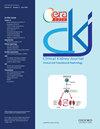实现无酸和无肝素透析:区域抗凝方法
IF 3.9
2区 医学
Q1 UROLOGY & NEPHROLOGY
引用次数: 0
摘要
背景与假设 在慢性间歇性血液透析中,肝素和含酸透析液是标准的抗凝剂。目前已开发出使用不含钙、含柠檬酸盐的透析液进行区域抗凝(RA)的方法。我们将本中心常规使用的无钙、无枸橼酸透析液区域抗凝与全身肝素化进行了比较。方法 在一项回顾性、观察性、单中心、交叉研究中,我们对 15 名接受慢性血液透析的患者进行了检查,这些患者出血风险较高,且暂时无法使用肝素。这些患者接受了无钙和无柠檬酸盐透析液的临时 RA 治疗。我们对两个不同时期的透析成功率进行了比较:标准肝素化和使用无钙无枸橼酸透析液的 RA 程序。结果 我们对 15 名慢性血液透析患者进行了研究,比较了 30 次 RA 治疗和 28 次基于肝素的抗凝治疗,观察到 RA 组和肝素组的成功率均为 100%,中位治疗时间均为 240 分钟。没有早期体外循环(ECC)损失的报道。不过,我们注意到透析后 ECC 血栓形成评分存在显著差异,RA 组的总体血栓形成指数(GTI)更高,膜凝固评分更高(分别为 p &;lt; 0.007 和 p &;lt; 0.02)。未出现低钙血症或高钙血症症状。过滤后离子钙水平中位数在30分钟时为0.32 [0.29-0.39] mmol/L,患者离子钙水平中位数在60分钟时为1.19 [1.135-1.28] mmol/L。各组间每次透析动脉血压无明显差异。结论 我们的研究评估了在慢性血液透析中心使用无钙、无枸橼酸盐醋酸盐透析液的 RA 方法,发现这种方法很有效。虽然本研究未使用无酸透析液,但我们的研究结果表明,无酸透析液可能是先进透析技术发展的下一个前沿。本文章由计算机程序翻译,如有差异,请以英文原文为准。
Toward Acid and Heparin-Free Dialysis: The Regional Anticoagulation Approach
Background and hypothesis In chronic intermittent hemodialysis, heparin is the standard anticoagulant as is the use of acid-containing dialysate. Regional anticoagulation (RA) with a calcium-free, citrate-containing dialysate has been developed. We compared RA using a calcium-free, citrate-free dialysate, routinely used in our centre, to systemic heparinization. Methods In a retrospective, observational, single-centre, cross-over study, we examined 15 patients undergoing chronic hemodialysis who were at high risk of bleeding and temporarily unable to use heparin. These patients received temporary treatment with RA involving calcium-free and citrate-free dialysate. We compared the dialysis session success rates during two distinct periods: standard heparinization and RA procedure with a calcium-free and citrate-free dialysate. Results In our study of 15 patients on chronic hemodialysis which compared 30 RA sessions to 28 heparin-based anticoagulation session, we observed a 100% success rate with a median session duration of 240 minutes in both RA and heparin groups. No early extracorporeal circulation (ECC) loss was reported. However, we noted significant differences in the post-dialysis ECC thrombosis scores, with higher Global Thrombosis Index (GTI) and higher membrane coagulation scores in the RA group (p < 0.007 and p < 0.02, respectively). No hypocalcaemia or hypercalcemia symptoms occurred. Median post-filter ionized calcium levels were 0.32 [0.29–0.39] mmol/L at 30 minutes and median patient ionized calcium levels was 1.19 [1.135–1.28] mmol/L at 60 minutes. No significant difference in per-dialysis arterial blood pressure was observed between groups. Conclusion Our study evaluated the RA approach using a calcium-free, citrate-free acetate dialysate in a chronic hemodialysis centre and found it effective. Although an acid-free dialysate was not used in this study, our findings suggest it could be the next frontier in the evolution of advanced dialysis techniques.
求助全文
通过发布文献求助,成功后即可免费获取论文全文。
去求助
来源期刊

Clinical Kidney Journal
Medicine-Transplantation
CiteScore
6.70
自引率
10.90%
发文量
242
审稿时长
8 weeks
期刊介绍:
About the Journal
Clinical Kidney Journal: Clinical and Translational Nephrology (ckj), an official journal of the ERA-EDTA (European Renal Association-European Dialysis and Transplant Association), is a fully open access, online only journal publishing bimonthly. The journal is an essential educational and training resource integrating clinical, translational and educational research into clinical practice. ckj aims to contribute to a translational research culture among nephrologists and kidney pathologists that helps close the gap between basic researchers and practicing clinicians and promote sorely needed innovation in the Nephrology field. All research articles in this journal have undergone peer review.
 求助内容:
求助内容: 应助结果提醒方式:
应助结果提醒方式:


